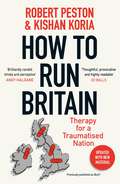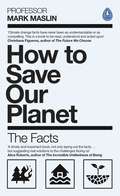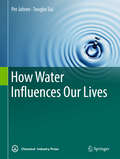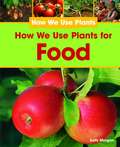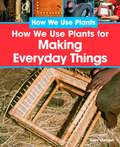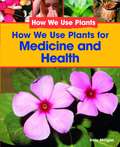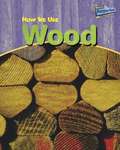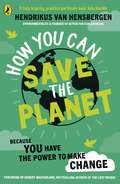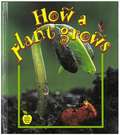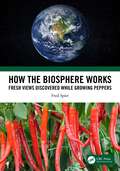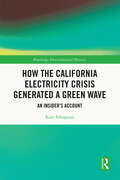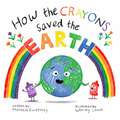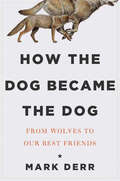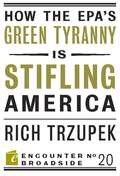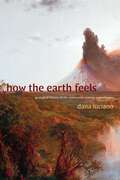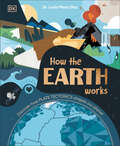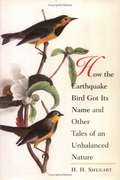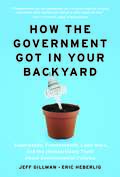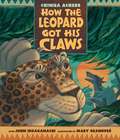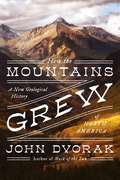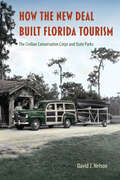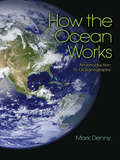- Table View
- List View
How To Run Britain: Therapy For A Traumatised Nation
by Robert PestonTHE MUST-READ BOOK FROM ITV'S ROBERT PESTON AND KISHAN KORIA, REVISED AND UPDATED FOLLOWING THE GENERAL ELECTION *Previously published as Bust?*---------Britain is facing uncertainty, threats and risk: new Prime Minister, new government, new political landscape, at home and abroad. But how much should change? And how much will change?How To Run Britain is a plea from Robert Peston and Kishan Koria to own what's gone wrong and make courageous reforms to everything, from the way we manage the economy to how we vote. We all know that, over the past fifteen years, British living standards have stagnated, inequality between - and within - communities has grown rampant, politicians have lost credibility and the trust of the nation. Millions say they are unheard and disenfranchised, victimised even. A far-right racist minority feels entitled to riot. But what do those problems really mean - and how do we fix them? How can politicians win the trust back from voters, from teachers, doctors, students, pensioners - all those who feel left behind by those who purport to act in their best interest?Peston and Koria's argument is simple: first, we must interrogate everything that has gone wrong, and build solutions from there. This is not the time to shy away from the recent past, nor should we indulge in it. Instead, we should take the lessons learned over the past fifteen years and build a future-focused, strategic plan for restoring economic, political and social security to the country we know and love.How To Run Britain is a manifesto for change in its simplest, clearest form, from the minds of two people who have seen it all.This is an updated, retitled edition of Bust? by Robert Peston and Kishan Koria, published in 2023.
How To Save Our Planet: The Facts
by Mark A. Maslin'Punchy and to the point. No beating around the bush. This brilliant book contains all the information we need to have in our back pocket in order to move forward' Christiana Figueres, Former Executive Secretary UN Climate Change Convention'Amazing book' Chris Evans, Virgin Radio Breakfast Show'Everyone should have this book' Rick Edwards, BBC Radio 5 Live'A timely and important book, not only laying out the facts...but suggesting real solutions to the challenges facing us' Professor Alice Roberts, Anatomist, Professor of Public Engagement in Science, University of Birmingham_________________________ How can we save our planet and survive the 21st century? How can you argue with deniers? How can we create positive change in the midst of the climate crisis? Professor Mark Maslin has the key facts that we need to protect our future. Global awareness of climate change is growing rapidly. Science has proven that our planet and species are facing a massive environmental crisis. How to Save Our Planet is a call to action, guaranteed to equip everyone with the knowledge needed to make change. Be under no illusion the challenges of the twenty-first century are immense. We need to deal with: climate change, environmental destruction, global poverty and ensure everyone's security. We have the technology. We have the resources. We have the money. We have the scientists, the entrepreneurs and the innovators. We lack the politics and policies to make your vision of a better world happen. So we need a plan to save our planet... How to Save Our Planet is your handbook of how we together can save our precious planet. From the history of our planet and species, to the potential of individuals and our power to create a better future, Maslin inspires optimism in these bleak times. We stand at the precipice. The future of our planet is in our hands. It's time to face the facts and save our planet from, and for, ourselves._________________________'A handbook of clearly established, authoritative facts and figures about the terrible toll we as humans have taken of our planet, plus ways in which we can lessen the impact. For laypeople like me, who can see what is happening but haven't always got the precise statistics to hand, it's hugely valuable' John Simpson CBE, BBC World Affairs Editor, Broadcaster, Author & Columnist'Saving the world is no small thing, but picking up this book's a good start' Paris Lees, Contributing Editor at British Vogue, campaigner'I love it. My kids love it' Chris Evans, Virgin Radio Breakfast Show'A no-nonsense crib sheet on the state of the world and how to help it' The I Newspaper
How Water Influences Our Lives
by Per Jahren Tongbo SuiThis beautifully illustrated book explains how water influences our culture; the many phases of water from ice to gas, its simple but still so unpredictable nature, and water resources on Earth; how water is distributed in ice, oceans, rivers, lakes and more; how it creates transport possibilities; how it produces and absorbs energy; how it is constantly changing the surface of the Earth; how there is enough water on Earth, yet sometimes there is too much or too litt≤ the role of water in recreation; and how water supplies us with food in a myriad of ways. Few things are like water - a subtle and thought-provoking element, so simple and yet complicated, so conspicuous yet unpredictable, so soft and peaceful yet powerful, and so universal yet unique. Water is by far the world's largest commodity. Though it belongs to all of us, it is still not shared by all. We very seldom take time to reflect on the many ways that water affects our lives. Though it would be too ambitious to believe that it claims all the meanings and roles of water, this book, by showcasing water's versatility and by sharing the experiences and insights gained by the two authors during their many travels across the globe, contributes to a greater awareness of the most important substance in our society - water. The book offers an insightful and intriguing read for anyone interested in science and culture related to water, from laymen to students and decision-makers.
How We Know What We Know about Our Changing Climate: Scientists and Kids Explore Global Warming
by Lynne CherryWhen the weather changes daily, how do we really know that Earth's climate is changing? Here is the science behind the headlines - evidence from flowers, butterflies, birds, frogs, trees, glaciers and much more, gathered by scientists from all over the world, sometimes with assistance from young "citizen-scientists." And here is what young people, and their families and teachers, can do to learn about climate change and take action. Climate change is a critical and timely topic of deep concern, here told in an age-appropriate manner, with clarity and hope. Kids can make a difference!
How We Use Plants for Food
by Sally MorganPlants are used to make so many foods that we eat! This title engages readers with easy do-it-yourself experiments as it explains the many fascinating ways plants can be made into food; from cereal, fruits and vegetables, to sugar and oils. Different parts of the plant are used to make these foods; and freshness and preservation are equally important.
How We Use Plants for Making Everyday Things
by Sally MorganMany of the things we use each day are made from plants. Readers may not realize that the clothes they wear or the rubber tires on their bicycle are made from plants. This book covers plant-based items from fabrics to paper. Students will have the opportunity to participate in the process as they learn how to make their own paper!
How We Use Plants for Medicine and Health
by Sally MorganPeople use plants for a variety of medicinal and health purposes from making herbal remedies and pain killers, to products for skin care and healthy teeth to fighting diseases like cancer. Readers will also have the chance to make their own plant remedy.
How We Use Wood
by Chris OxladeHow We Use Wood will give you answers to these and many other questions: Why is wood a good material for building boats? How do we get paper from wood? Why we use wood to make drain pipes?
How You Can Save the Planet
by Hendrikus van Hensbergen*Foreword by Robert Macfarlane, bestselling author of The Lost Words.*If you're worried about climate change, this book is an essential and reassuring read.We often feel like we don't have the power to make real change.But our small changes can add up to something BIG. Packed with reassuring step by step actions and easy to follow DIY activities, How You Can Save The Planet is the perfect gift for young activists who want to make a difference.With simple explanations, practical tips and stories from children across the world, this guide is ideal for young people who are worried about climate change and want to help our planet!Crafted by Hendrikus van Hensbergen, whose work is featured on BBC Bitesize[JP2] , this inspiring read is perfect for children at KS2. 'Every young person in the country should be given this book' Sir Tim Smit, Founder of The Eden Project'It's enlightening, inspiring and empowering' Kate Humble, TV presenter'Wonderfully informative, fun and practical [. . .] A great source of inspiration' The Rich Brothers, TV presenters
How a City Works (Let's-Read-and-Find-Out Science 2)
by D. J. WardRead and find out about how cities work in this colorfully illustrated nonfiction picture book.Millions of people live in cities around the world, but have you ever wondered how cities work? All those people need clean water to drink, a safe place to live, and a way to get all around the city. How do you take care of all those people’s needs? Read and find out all about the systems a city has to help keep everyone safe, healthy, and happy.This book on city systems will appeal to the young civil engineer. How a City Works is filled with fun, accurate art, and includes tons of information. For example, it answers the question: Where does all the electricity needed to make a city run come from? How a City Works covers water treatment, power, sewage, recycling, and transportation.How a City Works comes packed with visual aids like charts, sidebars, an infographic, and a funny, hands-on activity—how to clean up dirty “sewage” water, using puffed rice cereal, raisins, hot chocolate mix, and coffee filters.This is a clear and appealing science book for early elementary age kids, both at home and in the classroom. It's a Level 2 Let's-Read-and-Find-Out, which means the book explores more challenging concepts for children in the primary grades. The 100+ titles in this leading nonfiction series are:hands-on and visualacclaimed and trustedgreat for classroomsTop 10 reasons to love LRFOs:Entertain and educate at the same timeHave appealing, child-centered topicsDevelopmentally appropriate for emerging readersFocused; answering questions instead of using survey approachEmploy engaging picture book quality illustrationsUse simple charts and graphics to improve visual literacy skillsFeature hands-on activities to engage young scientistsMeet national science education standardsWritten/illustrated by award-winning authors/illustrators & vetted by an expert in the fieldOver 130 titles in print, meeting a wide range of kids' scientific interestsBooks in this series support the Common Core Learning Standards, Next Generation Science Standards, and the Science, Technology, Engineering, and Math (STEM) standards. Let's-Read-and-Find-Out is the winner of the American Association for the Advancement of Science/Subaru Science Books & Films Prize for Outstanding Science Series.
How a Seed Grows (Let's-Read-and-Find-Out Science 1)
by Helene J. JordanRead and find out about how a tiny acorn grows into an enormous oak tree in this colorfully illustrated nonfiction picture book.This is a clear and appealing environmental science book for early elementary age kids, both at home and in the classroom. Plus it includes a find out more activity section with a simple experiment encouraging kids to discover what a seed needs to grow.This is a Level 1 Let's-Read-and-Find-Out, which means the book explores introductory concepts perfect for children in the primary grades. The 100+ titles in this leading nonfiction series are:hands-on and visualacclaimed and trustedgreat for classroomsTop 10 reasons to love LRFOs:Entertain and educate at the same timeHave appealing, child-centered topicsDevelopmentally appropriate for emerging readersFocused; answering questions instead of using survey approachEmploy engaging picture book quality illustrationsUse simple charts and graphics to improve visual literacy skillsFeature hands-on activities to engage young scientistsMeet national science education standardsWritten/illustrated by award-winning authors/illustrators & vetted by an expert in the fieldOver 130 titles in print, meeting a wide range of kids' scientific interestsBook in this series support the Common Core Learning Standards, Next Generation Science Standards, and the Science, Technology, Engineering, and Math (STEM) standards. Let's-Read-and-Find-Out is the winner of the American Association for the Advancement of Science/Subaru Science Books & Films Prize for Outstanding Science Series.
How a plant grows (Crabapples)
by Bobbie KalmanHow A Plant Grows introduces children to the amazing lives of plants--from their beginnings, through their growth, to reproduction and death. Full-color illustrations and photographs accompany simple plant experiments.
How the Biosphere Works: Fresh Views Discovered While Growing Peppers
by Fred SpierHow the Biosphere Works: Fresh Views Discovered While Growing Peppers offers a simple and novel theoretical approach to understanding the history of the biosphere, including humanity’s place within it. It also helps to clarify what the possibilities and limitations are for future action. This is a subject of wide interest because today we are facing a great many environmental issues, many of which may appear unconnected. Yet all these issues are part of our biosphere. For making plans for the future and addressing our long-term survival and well-being, an integrated knowledge of our biosphere and its history is therefore indispensable. Key Features Documents what the biosphere is, and what our position as humans within it is today. Describes how the biosphere has become the way it is. Summarizes the novel simple theoretical model proposed in the book, and thus, how the biosphere functions. Predicts what the possibilities and limitations are for future human action Emphasizes how simple but careful observations can lead to far-reaching theoretical implications.
How the California Electricity Crisis Generated a Green Wave: An Insider's Account (Routledge Environmental History)
by Kurt SchuparraThis book provides the definitive account of a decade-long transformation of energy policy in California with rippling consequences. The author, a state government “insider” during much of this period, tells a story informed by personal experience, access to the key actors of the time (both then and now), and extensive research.California’s risky experiment in deregulating the state’s electricity market in the 1990s, resulting in manipulation from unscrupulous energy providers and necessitating government action, laid the foundation for a greener grid and greater energy efficiency in the early 2000s and beyond. The book follows the state’s energy journey through Democratic Governor Gray Davis’s administration and his Republican successor Arnold Schwarzenegger’s time in office, providing a detailed behind-the-scenes account. It highlights how this period influenced broader discussions of energy policy in the U.S., culminating in President Barack Obama pledging bold action and securing $90 billion for clean energy programs in the 2009 “stimulus” bill, the largest single “green” investment in history at that point in time. The energy crisis provided a springboard for green growth by discrediting deregulation, elevating public support, and establishing a political pathway for a growing array of sustainable energy advocates.This book engagingly balances policy considerations and political drama to reveal the untold details of how the electricity crisis paved the way for key climate and clean energy policies and offers unprecedented access to archival material from the Davis administration era. It will be a must-read for energy policymakers, researchers, and environmental historians.
How the Crayons Saved the Earth (How the Crayons Saved #5)
by Monica SweeneyWhat can crayons do to save the planet?Something is happening to our big green and blue Earth! Pollution is making it hard for plants to grow, for animals to play, and for oceans to stay clean. But what can anyone do about it? On a yucky, smoggy day, a box of seven special crayons steps up to help! These peppy crayons are on another adventure to bring friendship, teamwork, and thoughtfulness to the world—but this time, it&’s the world that needs help. With their unique personalities, quirky attitudes, and stick-to-itiveness, this rainbow of friends puts their heads and hearts together to find a way to save the Earth. How the Crayons Saved the Earth is a colorful book about the environment from the plucky crayons who brought you the How the Crayons Saved the Rainbow series. How the Crayons Saved the Earth reminds kids about the importance of taking care of the Earth and that teamwork and determination can make a real difference.
How the Dog Became the Dog: From Wolves to Our Best Friends
by Mark DerrThat the dog evolved from the wolf is an accepted fact of evolution and history, but the question of how wolf became dog has remained a mystery, obscured by myth and legend. How the Dog Became the Dog posits that dog was an evolutionary inevitability in the nature of the wolf and its human soul mate. The natural temperament and social structure of humans and wolves are so similar that as soon as they met on the trail they recognized themselves in each other. Both are highly social, accomplished generalists, and creatures of habit capable of adapting? homebodies who like to wander. How the Dog Became the Dog presents domestication of the dog as a biological and cultural process that began in mutual cooperation and has taken a number of radical turns. At the end of the last Ice Age the first dogs emerged with their humans from refuges against the cold. In the eighteenth century, humans began the drive to exercise full control of dog reproduction, life, and death to complete the domestication of the wolf begun so long ago. .
How the EPA's Green Tyranny is Stifling America
by Rich TrzupekThe relationship between environmental regulation and economic growth has gone from dysfunctional to disastrous under the leadership of Barack Obama's USEPA Administrator, Lisa Jackson. Jackson's EPA has assumed broad new powers and promulgated sweeping new regulations unlike anything that America has seen since the Clean Air Act and Clean Water Act were signed into law forty years ago. While much of the public has focused on the EPA's plans to regulate greenhouse gas emissions, the Agency's power grab extends into far more areas of society and the economy than fossil fuel use alone.Rich Trzupek explains why Obama's EPA is different and more dangerous, than any other since the Agency was created forty years ago. From the oceans to consumer products, from the manufacturing line to the showroom floor, the tentacles of this EPA are silently creeping into more and more parts of our lives as Lisa Jackson smilingly assures the nation that everything the EPA does generates revenue rather than costing industry billions of dollars and America hundreds of thousands of jobs.
How the Earth Feels: Geological Fantasy in the Nineteenth-Century United States (ANIMA: Critical Race Studies Otherwise)
by Dana LucianoIn How the Earth Feels Dana Luciano examines the impacts of the new science of geology on nineteenth-century US culture. Drawing on early geological writings, Indigenous and settler accounts of earthquakes, African American antislavery literature, and other works, Luciano reveals how geology catalyzed transformative conversations regarding the intersections between humans and the nonhuman world. She shows that understanding the earth’s history geologically involved confronting the dynamic nature of inorganic matter over vast spans of time, challenging preconceived notions of human agency. Nineteenth-century Americans came to terms with these changes through a fusion of fact and imagination that Luciano calls geological fantasy. Geological fantasy transformed the science into a sensory experience, sponsoring affective and even erotic connections to the matter of the earth. At the same time, it was often used to justify accounts of evolution that posited a modern, civilized, and Anglo-American whiteness as the pinnacle of human development. By tracing geology’s relationship with biopower, Luciano illuminates how imagined connections with the earth shaped American dynamics of power, race, and colonization.
How the Earth Works: Discover How Plate Tectonics Shapes Our Planet
by Dr. Lucia Perez-DiazSee below the surface of Earth and discover the secrets that lie beneath our feet in this fascinating book about Earth.Author Dr. Lucía Pérez-Díaz offers budding young Earth scientists aged 7-9 everything they need to decode the puzzle that is planet Earth.On a journey like no other, children will learn what our planet was once like, how and why it has changed, and what the future may hold. They will adventure through earthquakes and over towering mountains to learn about our landscapes and unlock clues to Earth’s long history.This Earth science book for children offers: A unique adventure through Earth for kids, covering the past, present and future of our planet’s geography.An in-depth look at the trending topics of Earth and the environment in relation to rising global temperatures.Information on topics like plate tectonics, and how human actions and the climate affect this.How the Earth Works digs into all that happens beneath our feet in an accessible and lively manner. The pages of this book are charged with Dr. Lucía Pérez-Díaz’s passion and expertise, as she helps us to explore the inner workings of our planet. Filled with dynamic illustrations, this geology book takes on plate tectonics in a digestible and adventurous way that you don’t want to miss!
How the Earthquake Bird Got Its Name: And Other Tales of an Unbalanced Nature
by H. H. ShugartAlthough people have been altering earth's landscapes to some extent for tens of thousands of years, humankind today is causing massive changes to the planet. Such widespread environmental change is accompanied by accelerating rates of species extinction. In this book, noted ecologist H. H. Shugart presents important ecological concepts through entertaining animal parables. He tells the stories of particular birds and mammals--the packrat, ivory-billed woodpecker, penguin, dingo, European rabbit, and others--and what their fates reveal about the interactions between environmental change and the extinctions or explosions of species populations. Change is the root of many planetary problems, but it is also an intrinsic feature of our living planet. Shugart explores past environmental change, discusses the non-existence of a "balance of Nature," and documents how human alterations have affected plants, soils, and animals. He looks with hope toward a future in which thoughtful people learn-and use-ecological science to protect the landscapes upon which terrestrial creatures depend.
How the Government Got in Your Backyard: Superweeds, Frankenfoods, Lawn Wars, and the (Nonpartisan) Truth About Environmental Policies
by Jeff Gillman Eric HeberligBiotechnology—the future or a genetic time bomb? Renewable fuels—the key to cleaner air or just corporate welfare? Greenhouse gasses—baking the earth to death or just a needless worry? Plant patents—improving gardens and farms or just profiteering? When you stop to think about it, the government has its hand in every important environmental issue. And with the left and the right raucously disagreeing about whether the government’s policies are for good or for evil, it’s impossible for a concerned citizen to know what to think.How the Government Got in Your Backyard distills the science, the politics, and the unbiased, nonpartisan truth behind hot-button environmental issues from pesticides to global warming. By clearly representing what the left says, what the right says, what the science is, and what the facts are, Gillman and Heberlig don’t set out to provide the answer—they light the path so concerned citizens can uncover their own true and informed opinion. In this season of political discontent, the unbiased truth about environmental policies—free of political agendas—is as refreshing as it is fascinating.How the Government Got in Your Backyard is not for Republicans or Democrats, liberals or conservatives. It’s for anyone who is ready to get to the bottom line.
How the Leopard got his Claws
by Chinua AchebeIn the beginning, all the animals lived as friends. Their king, the leopard, was strong but gentle and wise. Only Dog had sharp teeth, and only he scoffed at the other animals’ plan to build a common shelter for resting out of the rain. But when Dog is flooded out of his own cave, he attacks the leopard and takes over as king. And it is then, after visiting the blacksmith’s forge and knocking on Thunder’s door, that the angry leopard returns to regain his throne by the menace of his own threatening new claws. In a riveting fable for young readers about the potency and dangers of power taken by force, Nigerian writer Chinua Achebe, author of Things Fall Apart, evokes themes of liberation and justice that echo his seminal novels about post-colonial Africa.
How the Mountains Grew: A New Geological History of North America
by John DvorakThe incredible story of the creation of a continent—our continent— from the acclaimed author of The Last Volcano and Mask of the Sun.The immense scale of geologic time is difficult to comprehend. Our lives—and the entirety of human history—are mere nanoseconds on this timescale. Yet we hugely influenced by the land we live on. From shales and fossil fuels, from lake beds to soil composition, from elevation to fault lines, what could be more relevant that the history of the ground beneath our feet? For most of modern history, geologists could say little more about why mountains grew than the obvious: there were forces acting inside the Earth that caused mountains to rise. But what were those forces? And why did they act in some places of the planet and not at others? When the theory of plate tectonics was proposed, our concept of how the Earth worked experienced a momentous shift. As the Andes continue to rise, the Atlantic Ocean steadily widens, and Honolulu creeps ever closer to Tokyo, this seemingly imperceptible creep of the Earth is revealed in the landscape all around us. But tectonics cannot—and do not—explain everything about the wonders of the North American landscape. What about the Black Hills? Or the walls of chalk that stand amongst the rolling hills of west Kansas? Or the fact that the states of Washington and Oregon are slowly rotating clockwise, and there a diamond mine in Arizona? It all points to the geologic secrets hidden inside the 2-billion-year-old-continental masses. A whopping ten times older than the rocky floors of the ocean, continents hold the clues to the long history of our planet. With a sprightly narrative that vividly brings this science to life, John Dvorak's How the Mountains Grew will fill readers with a newfound appreciation for the wonders of the land we live on.
How the New Deal Built Florida Tourism: The Civilian Conservation Corps and State Parks
by David J. NelsonFlorida Historical Society Rembert Patrick Award Florida Book Awards, Silver Medal for Florida Nonfiction Countering the conventional narrative that Florida’s tourism industry suffered during the Great Depression, this book shows that the 1930s were, in reality, the starting point for much that characterizes modern Florida’s tourism. David Nelson argues that state and federal government programs designed to reboot the economy during this decade are crucial to understanding the state today. Nelson examines the impact of three connected initiatives—the federal New Deal, its Civilian Conservation Corps program (CCC), and the CCC’s creation of the Florida Park Service. He reveals that the CCC designed state parks to reinforce the popular image of Florida as a tropical, exotic, and safe paradise. The CCC often removed native flora and fauna, introduced exotic species, and created artificial landscapes that were then presented as natural. Nelson discusses how Florida business leaders benefitted from federally funded development and the ways residents and business owners rejected or supported the commercialization and shifting cultural identity of their state. A detailed look at a unique era in which the state government sponsored the tourism industry, helped commodify natural resources, and boosted mythical ideas of the “Real Florida” that endure today, this book makes the case that the creation of the Florida Park Service is the story of modern Florida.
How the Ocean Works
by Mark DennyThe world's oceans account for roughly 71 percent of the planet's surface and 99 percent of its livable volume. Any study of this huge habitat requires a solid foundation in the principles that underlie marine biology and physical and chemical oceanography, yet until now undergraduate textbooks have largely presented compilations of facts rather than explanations of principles. How the Ocean Works fills this gap, providing a concise and accessible college-level introduction to marine science that is also ideal for general readers. How are winds and currents driven? What is the dilemma of the two-layered ocean? Mark Denny explains key concepts like these in rich and fascinating detail. He explores early scientific knowledge of oceans, photosynthesis, trophic interactions and energy flow, and the impacts of human activities on marine and atmospheric systems. Focusing each chapter on a major topic and carefully explaining the principles and theory involved, Denny gives readers the conceptual building blocks needed to develop a coherent picture of the living ocean. How the Ocean Works is an indispensable resource that teaches readers how to think about the ocean--its biology, mechanics, and conservation.Provides a concise, up-to-date introduction to marine science Develops the conceptual basis needed to understand how the ocean works Explains fundamental principles and theory Includes color illustrations and informative diagrams Serves as a college textbook and a reference for general readers
